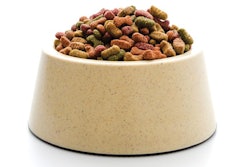
Three different types of machinery used to dry pet food and treats can influence how those products. Griffiths G. Atungulu, PhD, associate professor of agriculture at the University of Arkansas, discussed how drying techniques affect kibble and other pet products, during the Q&A of his Petfood Forum Connect-ED presentation.
Different machinery dries pet products in different ways, he said. One common method blows hot air over the kibble in a conductive drying process.
“The way we dry with air, you have heated air coming in contact with your product,” he said. “Then the heat eventually moves from the surface of the product through the material. That kind of process is completely different from what we would get if you are using something like a microwave.”
Microwave and infrared radiation for drying pet food
Microwave drying of a pet product heats up the water molecules in the material in a volumetric way through a kind of radiative heating, he said.
“If you look at the structure of the food material that's dried using convective heated air and a microwave dryer is going to be completely very different. The color can also change just because of the way the heat is moving through the material.”
Infrared dryers provide a third option for drying pet products. Infrared and microwave radiation both fall within the electromagnetic spectrum, Atungulu said, and therefore the techniques dry kibble and treats using similar physical principles.
However, because they have different wavelengths, the penetration of heat into the product is going to be very different, he said. Infrared has very shallow penetration and tends to heat the surface of the material, compared to microwave, which tend to heat deeper. Infrared, microwave and heated air dryers all differ from each other, which may provide varied tools for pet food manufacturers.
“I've seen cases where hybridizing those methods have brought completely different surface capabilities of the material,” he said.

















